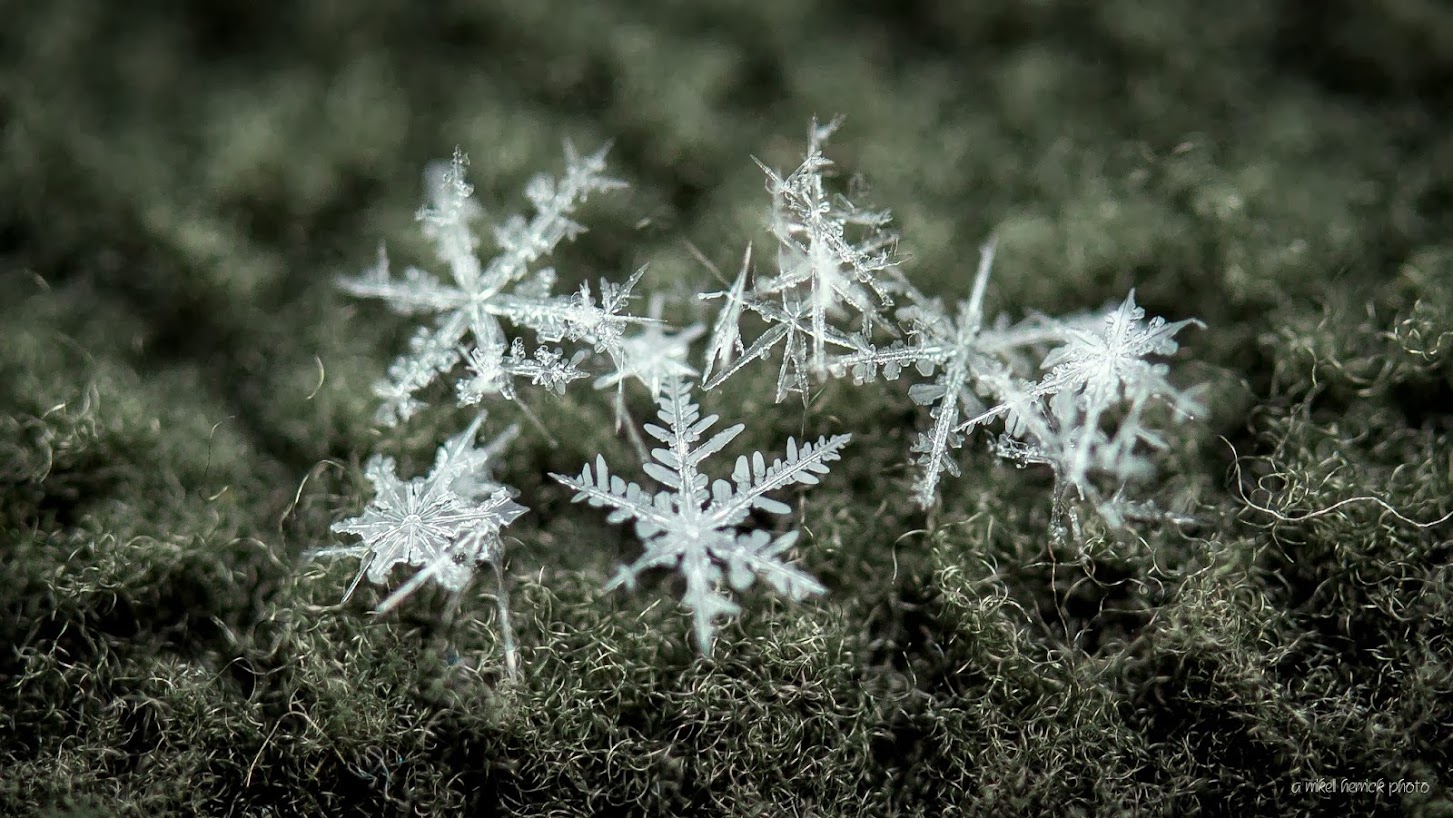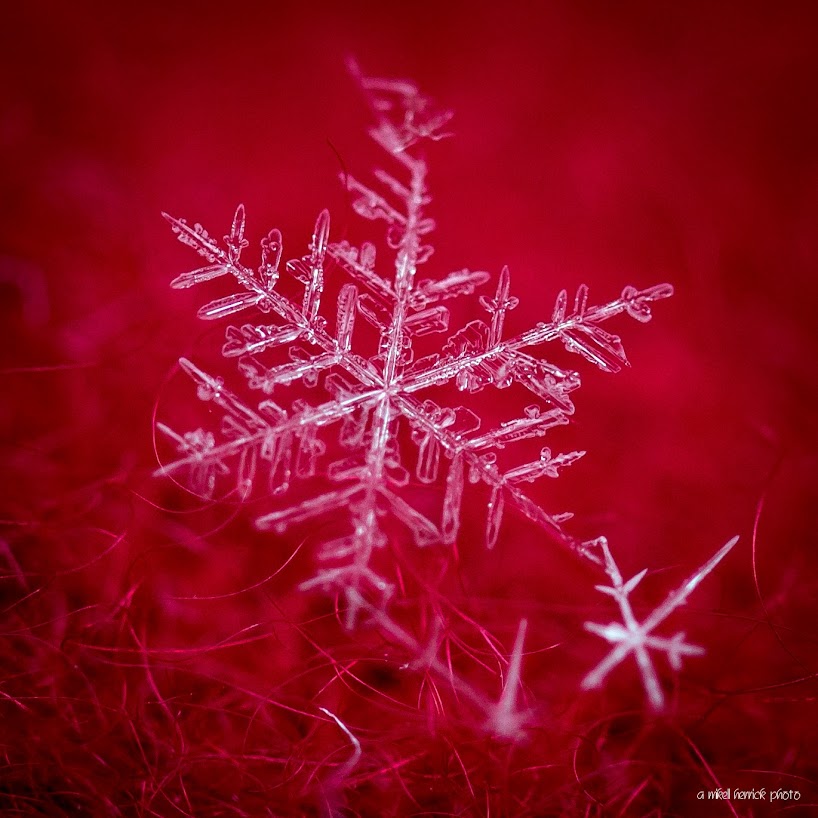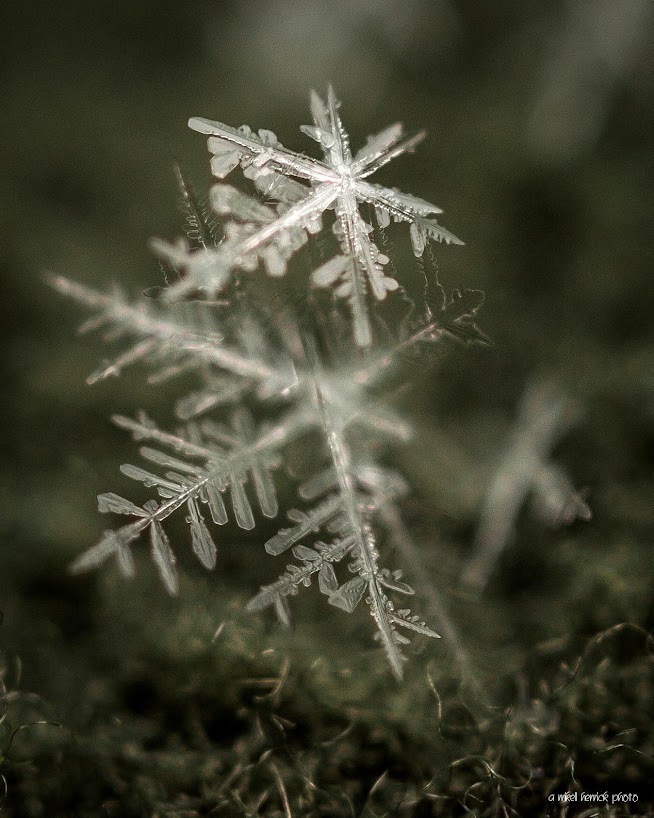I unfortunately do not have the equipment for such small objects.Kelly wrote:I keep hoping to inspire others to try it - but......no takers?
Snowflakes
- Kelly
- Editor

- Posts: 5601
- Joined: Sun Jun 08, 2008 9:23 am
- Camera Model: Canon EOS 50D, EOS 7D Mi & ii, Rebel t3i, Canon M50
- Location: West Henrietta, NY
- Contact:
From today's Rochester D&C.
College profs make life’s work of studying snowflakes
College profs make life’s work of studying snowflakes
By February, snow begins to lose its novelty for many — the shoveling, the driving, the cold. But if you stop and take a look at the snowflakes, in their uniqueness and serenity, they can be awe-inspiring.
“Silent, and soft, and slow descends the snow,” Henry Wadsworth Longfellow writes in “Snowflakes.”
Whether part of a dusting, coating, or misty blanket of snow, the delicate and hard-to-capture snowflake is a crystalline mystery. Forming hexagons, plates, columns or needles, snowflakes often have complex, intricate structures.
Kenneth Libbrecht and Michael Peres spend a lot of time catching snowflakes. They’re so fascinated, they’ve made the structures their life’s work.
Libbrecht, who teaches thermodynamics at California Institute of Technology in Pasadena, has been studying the formation of ice crystals, or snowflakes, for the past 15 years in a cold chamber at the school, trying to discover the science behind the mysteries of how they form.
They see the microscopic world of snowflakes as a grand symphony emerging from countless variables, ever-changing with endless variations, always surprising.
Complex world of snowflakes
Snowflake crystals begin as vapor, then as they fall through the earth’s atmosphere, they condense and take form. The rate of condensation — hence, the weather conditions such as humidity, temperature and wind — affect their shapes.
Even though they look white, they are really clear, just ice crystals.
“It’s like a broken pane of clear glass — when glass breaks, light is reflected on all its surfaces, so it looks white,” Libbrecht says.
Of course, it hasn’t snowed in Pasadena since the 1940s, so Libbrecht heads north to Cochrane, in northern Ontario, Canada, to do his field research.
“The best conditions for photographing large plate-like flakes are between 5 and 10 degrees Fahrenheit, with no wind, light snow, low clouds and it’s best to go out at night,” he says. “If you want to see snowflakes, go outside on a cold, clear night with a magnifying glass, and you’ll be able to see ice crystals under magnification with the naked eye.”
Libbrecht captures his images with a microscope attached to his camera. While there are practical applications for the study of crystals, for semi-conductors and optical lasers to name a few, his interest lies in witnessing the problems of crystal formation.
“Right now, we’re trying to explain triangular snowflakes. It seems there is an aerodynamic effect. The growth on one side is very fast, there’s instability and the way the crystals fall affects the shape,” he says.
How does a snowflake make it to the ground in a well-defined shape? “Snowflakes stay intact because they are very small, so the forces working on them are also very small, ” says Libbrecht.
Documenting the symphony
Peres, a professor at Rochester Institute of Technology, doesn’t usually have to travel in the winter to study the snow. He works out of the garage of his Brighton home, using black velvet to catch, then photograph snowflakes when it’s between 15 and 20 degrees out.
“When a student came to me to ask if it was possible to photograph snowflakes after she saw the work of William Bentley — the first person to capture a single snow crystal on film in 1885 — my first reaction was, ‘I don’t know how,’ Photographing an object that melts in temperatures over 28 degrees and that’s between one and two millimeters: Wow!” Peres says.
“But after some thought, I said, ‘Why not?’ And that’s where it began,” he says.
Once the snowflake falls on his velvet, Peres lifts the ice crystal with a needle and places it on a glass slide under a microscope; like Libbrecht, Peres uses a camera attached to his microscope for image capture.
Peres has installed a chilled light microscope on the campus of RIT so students can capture snowflakes 24/7 when conditions are right.
“Catching the right snowflake is a lot like going fishing,” says Peres, whose photographs were recently featured on The Weather Channel. “When conditions present themselves, you have to be ready. Once you catch one, you want to catch more.”
While Libbrecht’s work has practical applications, Peres’ snowflake photography is for no purpose other than pure discovery and joy.
“What I find interesting is the duplicity of this subject: photographed purely for their beauty, yet each snowflake is full of information,” he says. More here: http://www.democratandchronicle.com/sto ... s/5083139/
I am strong, because I've been weak.
I am fearless, because I've been afraid.
I am wise, because I've been foolish.
- Unknown
My NYFalls.com Team Page
Scenes from a Public Market
New York Historic
I am fearless, because I've been afraid.
I am wise, because I've been foolish.
- Unknown
My NYFalls.com Team Page
Scenes from a Public Market
New York Historic
- Kelly
- Editor

- Posts: 5601
- Joined: Sun Jun 08, 2008 9:23 am
- Camera Model: Canon EOS 50D, EOS 7D Mi & ii, Rebel t3i, Canon M50
- Location: West Henrietta, NY
- Contact:
No idea how they did this - but here's a video of snowflakes forming.
[BBvideo 700,419]http://vimeo.com/87342468[/BBvideo]
[BBvideo 700,419]http://vimeo.com/87342468[/BBvideo]
I am strong, because I've been weak.
I am fearless, because I've been afraid.
I am wise, because I've been foolish.
- Unknown
My NYFalls.com Team Page
Scenes from a Public Market
New York Historic
I am fearless, because I've been afraid.
I am wise, because I've been foolish.
- Unknown
My NYFalls.com Team Page
Scenes from a Public Market
New York Historic
- Mikell
- Board Expert

- Posts: 642
- Joined: Mon Oct 27, 2008 5:50 pm
I finally had a chance to try some snowflakes again this winter...it's been eluding me but I figured it was just patience and the right kind of snow falling so I took another stab at it.
The snow was falling clumps one day so it was hard to isolate a single flake...and the next day it seems the flakes were really just specks ...parts of flakes.
I'm not as good as Kelly - the master - but I was happy to finally get a few images that I don't mind sharing.






The snow was falling clumps one day so it was hard to isolate a single flake...and the next day it seems the flakes were really just specks ...parts of flakes.
I'm not as good as Kelly - the master - but I was happy to finally get a few images that I don't mind sharing.






Mikell
- Matt
- President

- Posts: 13374
- Joined: Sun Apr 23, 2006 5:01 pm
- Camera Model: Olympus OMD EM-1 m1, m2; Panasonic GM5, Osmo Pocket
- Location: Rochester, NY
- Contact:
I think those are fantastic! Really close up too. what setup did you use?
- Kelly
- Editor

- Posts: 5601
- Joined: Sun Jun 08, 2008 9:23 am
- Camera Model: Canon EOS 50D, EOS 7D Mi & ii, Rebel t3i, Canon M50
- Location: West Henrietta, NY
- Contact:
Yeah! Beautiful, Mikell! The biggest challenge is really just hanging out in the cold, isn't it?
I am strong, because I've been weak.
I am fearless, because I've been afraid.
I am wise, because I've been foolish.
- Unknown
My NYFalls.com Team Page
Scenes from a Public Market
New York Historic
I am fearless, because I've been afraid.
I am wise, because I've been foolish.
- Unknown
My NYFalls.com Team Page
Scenes from a Public Market
New York Historic
- Matt
- President

- Posts: 13374
- Joined: Sun Apr 23, 2006 5:01 pm
- Camera Model: Olympus OMD EM-1 m1, m2; Panasonic GM5, Osmo Pocket
- Location: Rochester, NY
- Contact:
[BBvideo 700,419]http://www.youtube.com/watch?v=X7oliEU0B1s[/BBvideo]
Here's a fresh view... instead of on fabric, this photographer focuses on the one flake that sticks up from a pile
[BBvideo 700,419]http://www.youtube.com/watch?v=cJzPVsIF4-s[/BBvideo]
Here's a fresh view... instead of on fabric, this photographer focuses on the one flake that sticks up from a pile
[BBvideo 700,419]http://www.youtube.com/watch?v=cJzPVsIF4-s[/BBvideo]
- Mikell
- Board Expert

- Posts: 642
- Joined: Mon Oct 27, 2008 5:50 pm
Thanks Matt & Kelly... yes, sitting outside in the cold is the hardest part!!! Though, the days I tried, it wasn't too bad...snowflakes were melting a bit one day which presents its own challenges...and the next day they were specks and not great flakes...
Matt - I used my 60mm macro lens and used Program Mode - which I'm sure isn't the best setting...but I didn't really know what to use. I will check out those videos...might get another chance to try before the winter's over...doesn't look like it's ending any time soon.
60mm
f2.8
1/90 SS
ISO was between 150 and 320
I basically didn't know what I doing and am surprised I got photos as good as I did!!! hahahaha

Matt - I used my 60mm macro lens and used Program Mode - which I'm sure isn't the best setting...but I didn't really know what to use. I will check out those videos...might get another chance to try before the winter's over...doesn't look like it's ending any time soon.
60mm
f2.8
1/90 SS
ISO was between 150 and 320
I basically didn't know what I doing and am surprised I got photos as good as I did!!! hahahaha
Mikell



